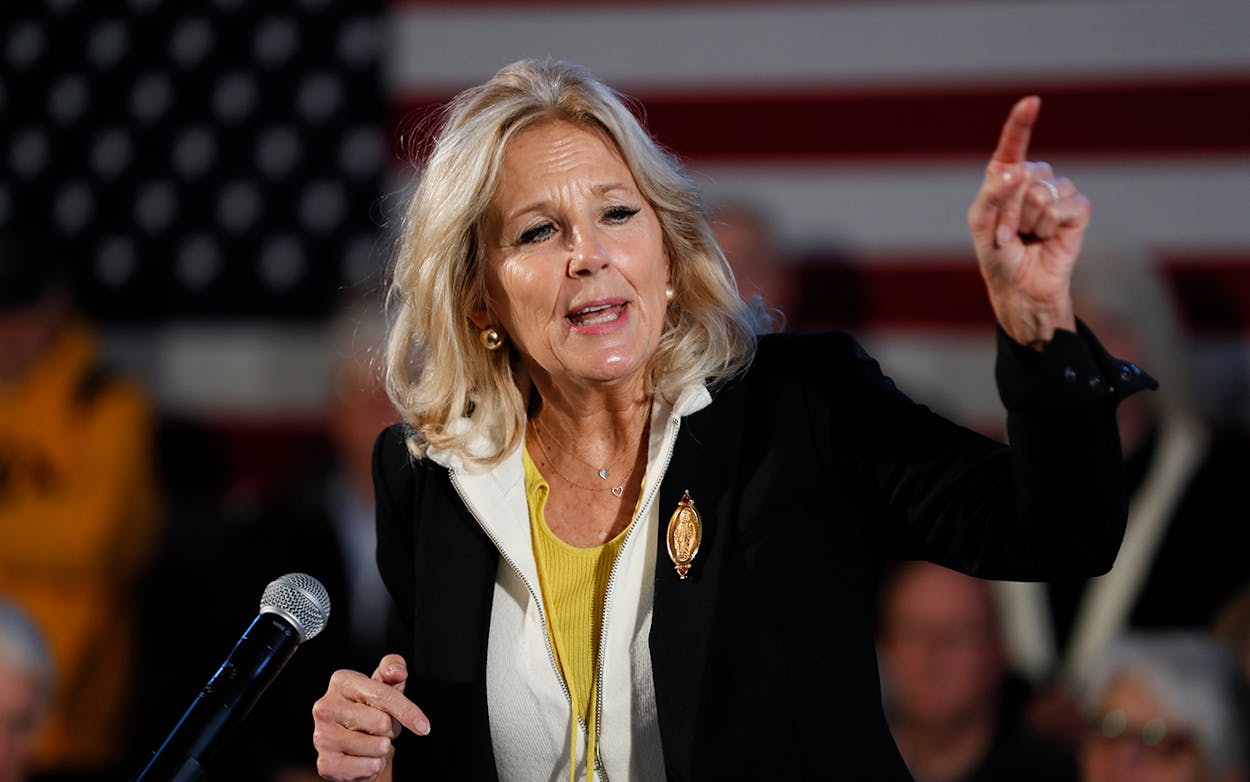On Sunday, former second lady Jill Biden donned a pair of calf-high rubber boots and trudged through thick, muddy fields littered with hundreds of tents and tarps in the Matamoros refugee camp across the border from Brownsville. She was there to bring Christmas cheer to the estimated two thousand migrants, mostly Central Americans, who are idling across the border as a result of the Remain in Mexico policy. Biden helped serve tamales with beans and rice, and later handed out Christmas toys to migrant children.
Biden, who of course is married to Joe Biden, seemed visibly shocked as she walked the grounds of the growing camp with U.S. Representative Filemon Vela, D-Brownsville. Their tour guides included Sister Norma Pimentel, head of the Catholic Charities of the Rio Grande Valley, as well as Bishop Daniel Flores of Brownsville.
“It’s not who we are as Americans,” Biden said after spending more than two hours at the camp. “We are a welcoming nation, but that’s not the message that we’re sending at the border. We’re saying, ‘Stop. Don’t come in.’”
This marks the second presidential campaign to visit this city of more than half a million people this year. Former San Antonio mayor Julián Castro visited the camp in October. The city is considered so dangerous that the U.S. State Department last week issued a Christmas travel warning advising Americans to stay away from Matamoros and the entire state of Tamaulipas, where the city is located, because of crime, especially kidnappings. “There’s so much danger here for the families, for the young women, for the girls, from kidnapping to sex trafficking to disease to violence,” Biden said. “There’s so much here that needs to be addressed.”
Her visit comes at a time of transition for the camp in what seems to be a tacit acknowledgment by both the Mexican government and the inhabitants that they are here for the long haul. That’s not to say conditions are improving; the camp seems to have deteriorated as more people arrive. There is no order to the layout of the hundreds of tents, and many people are now occupying space between bushes covered only by tarps. There are now nearly 60,000 people believed to be part of the Remain in Mexico program, formally called the Migrant Protection Protocols. Aid workers are now guessing upward of three thousand migrants may be in Matamoros, although not all are staying in the camp.

For the first time, there are visible signs of support from the Mexican government. More than thirty portable latrines have replaced the three overworked and filthy latrines that were available all summer. Thanks to new cement shower stalls, migrants no longer have to bathe in the filthy Rio Grande. But to get to these facilities, migrants must trek several blocks farther into the city and away from the international bridge where they have been staying—where danger from outside predators always lurks.
This weekend, I saw a stronger sense of determination than in the past among these mostly Central Americans waiting their turn to plead their cases for asylum in U.S. immigration courts. The inhabitants, some of whom now have court dates as far away as next July, realize that this muddy patch near the Rio Grande is their new home for an indefinite period. That determination is in their voice as they are beginning to better understand how complex the immigration process is.
I first met Vanessa Villalobos, from Honduras, in August when she told me that her immigration court date in the United States wasn’t until October. On Sunday, she told me she and her husband, Fernando Montoya, were now due in court again in March. It would mark the third time she will be in immigration court. She said this as she bounced her six-month-old daughter, Jimena, on her lap. The child arrived with her parents in Matamoros when she was two months old, meaning she has spent most of her life in this camp.
Villalobos was buoyed when she told me the news about fellow Honduran Carolina Caranza, who lived in an adjacent tent in Matamoros and whom I had also met in August and had visited several times. Because of Caranza’s pregnancy and two-year-old daughter, U.S. immigration authorities allowed the family to wait for their proceedings in Houston. “She made it!” Villalobos said.
- More About:
- Joe Biden






